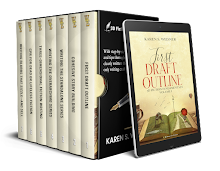Who Came First? {Astounding Advances in Electronic
Publishing}, Part 2
by Karen S. Wiesner
E-books and e-publishing
have really advanced in the last three decades. When I first entered this arena
in 1998, e-books were the ugly stepsister of "real books". Fast-forward
thirty years, and it's a whole different world now than those early pioneering
days in the industry. Last week, I posted the first part of an article I wrote
in 2003, when e-books and e-publishing still hadn't made much of an impact. Back
then, universal acceptance of them always seemed out of reach. Reflecting on changes
keeps history relevant. To that end, this week, I'm posting Part 2.
WHO
CAME FIRST?
by Karen S. Wiesner
© 2003 as featured in ELECTRONIC
PUBLISHING The Definitive Guide, 2003 Edition by Karen S. Wiesner, published by
Hard Shell Word Factory OOP
In the
Beginning…
The question "Who were the first
electronic publishers?" can never be answered with any real degree of
accuracy, although I’ve attempted to shed as much light as possible on this
mystery with this essay. The foremost reason it would be impossible to pinpoint
such a thing is because, while several e-publishers have been around for a long
time and continue to do business to this day (though perhaps not publishing e-books
any longer), there could conceivably be hundreds of e-publishers who originated
with the advent of the computer in the 1940s that have either gone out of
business or the owners died themselves. (Michael Hart of Project Gutenberg
says: "I only ever heard of one Etext from the 40s…some religious
thing.") Because we can’t include these defunct or deceased e-publishers,
we can’t pinpoint true accuracies.
Also, how can you ever pinpoint a
"first" when all aspects of the publishing industry are based on
growth—building on what was already there?
Multiplying the confusion, you might
ask what the definition of an ’electronic publisher’ is. It could mean a
company that publishes original e-books (like Hard Shell or New Concepts). Or
it could mean a content provider—basically, someone who secures the rights to
works out of print and converts them to e-books (like Project Gutenberg or
Alexandria Digital Literature). An e-publisher could also be one who puts out
e-zines, newsletters, or publishes articles, etc. online and so on. For
purposes of this essay, I focus only on e-book publishers that publish original
electronic novels or novellas, as well as those that publish out of print
titles/re-prints of novels and/or novellas.
In addition to these things,
complexities arise when you take into account that, of late, e-publishing is
becoming more like traditional publishing and traditional publishing is
becoming more like electronic publishing. As the heroine in the futuristic
thriller The Terminator said, "A person could go crazy thinking
about this."
Nevertheless, it is a fact that
electronic publishing was happening in the 1970s, in what some of us will find
fascinatingly "primitive" ways.
Project Gutenberg began in 1971 when
Michael Hart was given an operator’s account with $100,000,000 of computer time
in it by the operators of the Xerox Sigma V mainframe at the Materials Research
Lab at the University of Illinois. "In the overall point-of-view, you
could say I invented e-publishing," Michael states. He decided that the
greatest value created by computers would not be computing, but would be the
storage, retrieval, and searching of what was stored in our libraries.
Ironically, Michael points out, "Instead of embracing the possibilities, governments
around the world have extended and re-extended copyrights to keep the vast
majority of information off the internet." The philosophy Project
Gutenberg was based on was: anything that can be entered into a computer can be
reproduced indefinitely...what Michael termed "Replicator
Technology"—once a book or any other item (including pictures, sounds, and
even 3-D items can be stored in a computer), then any number of copies can and
will be available. Everyone in the world, or even not in this world (given
satellite transmission) can have a copy of a book that has been entered into a
computer. In fact, Project Gutenberg is available on several satellites,
as well as various versions of the metal disks being sent into space. Shannon
Lucid also took one of Project Gutenberg’s CDs on her record stay aboard Mir.
Says Michael of the beginning of Project Gutenberg: "Once I realized what
could be done with the internet, that it could be the start of the
"Neo-Industrial Revolution," that it was, in essence, a very primitive
combination of the Star Trek communicators, transporters and replicators, I
just had to keep on providing an example of "Unlimited Distribution."
"When I entered this, there were
only about 100 people on the entire internet. The dot-coms didn’t really come
along until 20-25 years later... The first other Etext collection I heard of
was the Oxford Text Archive, but they only believed in "Limited
Distribution" of the most elitist manner, as you might well imagine. Our
first Etexts we made so long ago that THEY WERE ALL IN CAPS, since
computers didn’t do lowercase yet, and with a limited supply of punctuation
marks."
In the ’70s, Bob Gunner (Cyber-Pulp
Houston/USA ePublishing) published "fan-zines" for comic book
collectors as a hobby. He was also the SYSOP for the local BBS called "The
Comic Crypt" and used a Commodore 64 OS and a bunch of daisy-linked disk
drives. Additionally, he’d been writing his own horror/fantasy stories and
wanted a way to distribute his work to readers. To that end, Bob began creating
ASCII Text files and distributing them originally from his BBS, and then, when
America Online and Prodigy were introduced, through their member downloads
library. When Mosaic-based (or graphic) web browsing became popular, he moved
his operations to a local internet provider service and built a homepage for
the company.
Serendipity Systems was started in
1986 by John Galuszka to promote the, then esoteric, idea of electronic books.
John says, "Keep in mind that computers typically had 64K of memory, ran
at 4.77MHz, and had floppy drives of 160K capacity; most monitors displayed 80
characters by 24 lines of text, graphics were rare, and color was very expensive.
Hardware limitations were a critical factor. For example, when I couldn’t find
interactive hypertext fiction, I designed one, only to discover that the
hardware (1985) could not support such a large and complicated program."
Galuszka created and sold an
electronic book display program called PC-BOOK in 1990. It created a
stand-alone book program—press the PG DN key and the next screen of text
appeared. This program, written in Turbo Pascal, featured numbered pages and
also a bookmark so that the reader could keep track of where he was in the
book. Other early e-publishers distributed their work in the form of word
processor files, or generic ASCII (a la Project Gutenberg) files which
required a word processor to display. Serendipity Systems decided to
concentrate on publishing and let others do the programming.
By the early 1990s, like-minded
enthusiasts gathered at Genie’s Digital Roundtable, and/or were members of the
Digital Publishing Association (DPA) founded by Dr. Ron Albright. Galuszka was
a member of the Board of Directors of the DPA. In 1992, the world of electronic
publishing numbered a few hundred planet-wide pioneers. By the time GEnie
folded, the internet was becoming popular, and "Windows" was
replacing "DOS." Enthusiasts abandoned GEnie for "The Net."
The DOS-based e-books in Serendipity System’s growing collection were converted
to Windows-compatible editions, then morphed into HTML documents for the internet.
When asked about other early pioneers
in the e-publishing field, John points out the following: "Ted Husted’s
DOS program IRIS may have been the first commercially available electronic book
publishing program (1989; shareware; $8.00). Our program PC-BOOK was available
in 1990, but at that time Husted and I did not know of each other. Husted also
published several books using his program. Husted later created the DART
program (shareware; $24.00) which had expanded multi-media features. Both
programs also worked with 'text reader' programs, so that vision-impaired
readers could access the books.
"Shortly thereafter, others began
doing the same thing: programming electronic book engines and publishing books.
There may have been as many as a dozen different e-book engines available by
the early 1990s.
"Jeff Napier published a variety
of non-fiction works with his programs.
"Charles Wiedermann offered a
number of titles and programs.
"Rod Wilmot created a hypertext
poem, "Everglade," and authored the hypertext ORPHEUS program."
When Eastgate Systems was founded in
1982, it was publishing/producing mostly computer games and small software
goodies like Fontina (which organizes long font lists spatially). In 1987,
Eastgate published its first hypertext fiction: Afternoon, a story by
Michael Joyce. The story was originally published on floppy disk and packaged
in a printed vinyl casing. Eastgate editor Diane Greco says of that
sentimentally archaic offering, "Very incunabular—I bet that original
packaging is worth some money now!"
J. Neil Schulman began distributing
books via computer media in December 1987 via SoftServ. The short answer as to
why he turned to e-publishing: "…because traditional publishing always
placed the interests of the author dead last. Everyone else in the bookselling
pipeline—editors, artists, marketing people, sales representatives,
typesetters, printers, shipping clerks and bookstore clerks—made enough off an
author’s book to be able to support their families and make regular payments on
their cars and mortgages. Except for a small number of anointed 'bestselling'
authors, all the others were being marginalized and suffering financial
catastrophes… As an author, I decided this was a bad thing and started looking
into ways of getting past the existing publishing industry." Schulman’s latest
venture is Pulpless.com, began in 1996.
BiblioBytes was founded in January
1993 by Glenn Hauman (dubbed a "young Turk of publishing" in the New
York Observer and "a Silicon Alley veteran" by Crain’s, was a
founding board member of WWWAC and a consultant for Simon & Schuster
Interactive and Ballantine as well as a co-founder of Hell Kitchen’s Systems),
Todd Masco and Andrew Bressen with the purpose of selling electronic
publications over the internet. As they began to prepare books, they came to
the realization that nobody was preparing a way to conduct commerce over the
’Net in time to meet their scheduled launch date, so they also began to pursue
the creation of a financial exchange system for the internet. They conducted
their first giveaway in August 1993 in collaboration with Ace Books and
conducted their first sales in July of 1994. Their web page went up in October
of 1994. Their business model is based on the philosophy of allowing readers to
read a book free with ads, or without ads for a price. BiblioBytes obtains
rights to place books on the Web, and sponsors buy ad space inside the online
book. BiblioBytes prepares the book for publication on the Web and the
advertisers are charged for each banner displayed on the pages for that book.
BiblioBytes shares this advertising revenue with the author. Their first
offerings came as 800K floppy disks. Glenn remembers some of the early
publishers in electronic books were: "Laura Fillmore of the Online Book
Store (now Open Book Systems (OBS), began published in 1992); Brad Templeton at
Clarinet (now ClariNet Communications, began publishing in 1989); Voyager, J.
Neil Schulman at SoftServ (distributed books via computer media starting
December 1987) and Pulpless.com (began
in 1996) and, the grandpappy of all of us, Michael Hart at Project Gutenberg (began
in 1971)."
Nancy McAllister, of C&M Online
Media, Inc., has had a long history in print publishing and also in multimedia,
e.g. film, filmstrips, slides, microfilm—sound and images and text working
together. She began online publishing on the internet in 1990 as the managing
editor of a peer-reviewed journal in the humanities. In January 1994, she began
to acquire books to publish on the WWW. Nancy says, "I wanted to see how
print publishing would move to the internet. What skills were valuable and what
new skills would have to be learned." Other than for academic publishing,
informational exchange, self-publishers and vanity publishers, Nancy knew of no
other e-publishers at that time. "Publishing online is, even minimally as
a self-publisher or vanity publisher, labor intensive. It is also somewhat
expensive. And in those days, ISPs were very unreliable and domain names were
not common. After the third ISP crash, a publisher might give up. Also, books
were sold without benefit of credit card capabilities. Shareware or modified
shareware was the only way to sell, and most people didn’t pay for what they 'bought'.
It was nearly impossible, too, to protect intellectual property in any
satisfactory way. Encryption was either nonexistent or too soft. At that time,
the government didn’t allow the use of tough encryption codes."
Ray Hoy had been a professional editor
and writer for 40 years, so starting his own publishing company seemed like a
natural thing to do. He established The Fiction Works in 1994 with the idea of
producing strictly audiobooks (full theatrical productions, no less). As to why
he turned to e-publishing, Ray says "Author Patricia White was responsible
for getting me into the electronic publishing business, so I’m going to blame
her. The third or fourth audiobook that we released was Patricia’s fantasy
yarn, THE SEVENTY-NINTH PRINCE. Pat called me after she received her author
copies and asked me if I’d given any thought to producing e-books. Frankly I
hadn’t, as I was busy with the audiobooks. I thought about it later that night
and realized how easy it would be to get into e-publishing, since I already had
a pretty good selection of scripts. So, I jumped into the e-book business with
both feet, and it has been a wild ride ever since." It didn’t take Ray
long to figure out that publishing e-books was anything but easy. They followed
the evolutionary trail along with every other e-publisher, by presenting their
books in text format, then RTF, then HTML, then Adobe Acrobat, then on and on.
"Until one file format proves superior, producing e-books will continue to
be your basic publishing nightmare," Ray says. "It’s expensive enough
to pay for readers, editors and artists, but then the real costs come into play
when it comes time to convert the scripts to the various file formats
needed." Currently, The Fiction Works publishes their books in text, HTML,
Adobe Acrobat, PalmOS, and XML file formats.
The Great American Publishing Society
(GR.AM.P.S.) was founded in 1975. According to Stephen Ellerin, publisher,
"Although we began using desktop computers to create paper-based
(conventionally-bound) books in 1981, our first fully-electronic book-on-CD
came in 1994."
Marilyn Nesbitt, CEO of DiskUs
Publishing, says, "I had a desktop publishing business called DiskUs
Publishing that I opened in 1995 and we sold booklets, CDs and works on disks.
I didn’t call these e-books but that’s what they were. (I just didn’t realize
at the time that there were actual things called e-books) when I got my
business license for DiskUs which was back in 1995. We put an author’s book on
a computer disk for them and also made them a bound book of their work (spiral
and then later VeloBind). We sold these in our shop for them. Then we expanded
and started a web presence in early 1997 where we had e-books that could be
downloaded for free while we were reading submissions and we sold our first
e-book in early 1998."
Other small press electronic
publishing companies became to emerge more rapidly toward the latter half of
the 1990s. In 1999, mass market publishers began to take notice of this growing
trend and dipped their own toes in the constantly churning waters known as
electronic publishing with strategies that wouldn’t really allow them to fail
as they experimented, as we’ve seen and will continue to see throughout the timeline,
provided next.
Next week, I'll post the
timeline.
Karen Wiesner is an award-winning,
multi-genre author of over 150 titles and 16 series.
Visit her website here: https://karenwiesner.weebly.com/
and https://karenwiesner.weebly.com/karens-quill-blog
Find out more about her books and see her art
here: http://www.facebook.com/KarenWiesnerAuthor
Visit
her publisher here: https://www.writers-exchange.com/Karen-Wiesner/






































